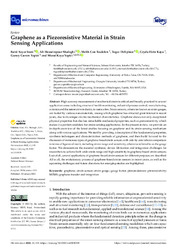Graphene as a piezoresistive material in strain sensing applications
| dc.contributor.author | Irani, F. S. | |
| dc.contributor.author | Shafaghi, A. H. | |
| dc.contributor.author | Tasdelen, M. C. | |
| dc.contributor.author | Delipinar, T. | |
| dc.contributor.author | Kaya, C. E. | |
| dc.contributor.author | Yapıcı, Güney Güven | |
| dc.contributor.author | Yapıcı, M. K. | |
| dc.date.accessioned | 2023-08-17T11:51:01Z | |
| dc.date.available | 2023-08-17T11:51:01Z | |
| dc.date.issued | 2022-01-12 | |
| dc.identifier.issn | 2072-666X | en_US |
| dc.identifier.issn | 2072-666X | |
| dc.identifier.uri | http://hdl.handle.net/10679/8713 | |
| dc.identifier.uri | https://www.mdpi.com/2072-666X/13/1/119 | |
| dc.description.abstract | High accuracy measurement of mechanical strain is critical and broadly practiced in several application areas including structural health monitoring, industrial process control, manufacturing, avionics and the automotive industry, to name a few. Strain sensors, otherwise known as strain gauges, are fueled by various nanomaterials, among which graphene has attracted great interest in recent years, due to its unique electro-mechanical characteristics. Graphene shows not only exceptional physical properties but also has remarkable mechanical properties, such as piezoresistivity, which makes it a perfect candidate for strain sensing applications. In the present review, we provide an in-depth overview of the latest studies focusing on graphene and its strain sensing mechanism along with various applications. We start by providing a description of the fundamental properties, synthesis techniques and characterization methods of graphene, and then build forward to the discussion of numerous types of graphene-based strain sensors with side-by-side tabular comparison in terms of figures-of-merit, including strain range and sensitivity, otherwise referred to as the gauge factor. We demonstrate the material synthesis, device fabrication and integration challenges for researchers to achieve both wide strain range and high sensitivity in graphene-based strain sensors. Last of all, several applications of graphene-based strain sensors for different purposes are described. All in all, the evolutionary process of graphene-based strain sensors in recent years, as well as the upcoming challenges and future directions for emerging studies are highlighted. | en_US |
| dc.description.sponsorship | Sabanci University ; TÜBİTAK | |
| dc.language.iso | eng | en_US |
| dc.publisher | MDPI | en_US |
| dc.relation.ispartof | Micromachines | |
| dc.rights | openAccess | |
| dc.rights | Attribution 4.0 International | |
| dc.rights.uri | https://creativecommons.org/licenses/by/4.0/ | |
| dc.title | Graphene as a piezoresistive material in strain sensing applications | en_US |
| dc.type | Review | en_US |
| dc.publicationstatus | Published | en_US |
| dc.contributor.department | Özyeğin University | |
| dc.contributor.authorID | (ORCID 0000-0001-5692-4809 & YÖK ID 163236) Yapıcı, Güven | |
| dc.contributor.ozuauthor | Yapıcı, Güney Güven | |
| dc.identifier.volume | 13 | en_US |
| dc.identifier.issue | 1 | en_US |
| dc.identifier.wos | WOS:000746968700001 | |
| dc.identifier.doi | 10.3390/mi13010119 | en_US |
| dc.subject.keywords | Gauge factor | en_US |
| dc.subject.keywords | Graphene | en_US |
| dc.subject.keywords | Graphene transfer and integration | en_US |
| dc.subject.keywords | MEMS | en_US |
| dc.subject.keywords | Piezoresistance | en_US |
| dc.subject.keywords | Piezoresistivity | en_US |
| dc.subject.keywords | Strain gauge | en_US |
| dc.subject.keywords | Strain sensor | en_US |
| dc.identifier.scopus | SCOPUS:2-s2.0-85123206418 | |
| dc.relation.publicationcategory | Review - Institutional Academic Staff |
Files in this item
This item appears in the following Collection(s)
Share this page




